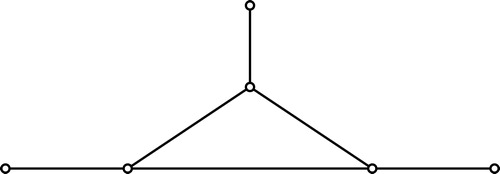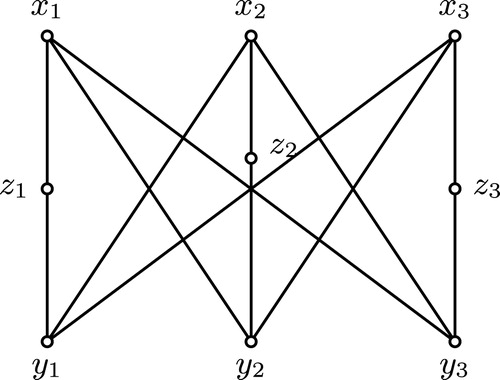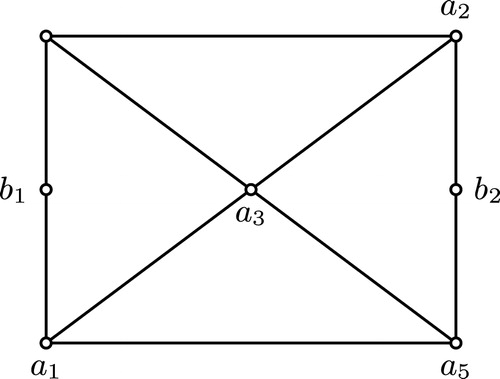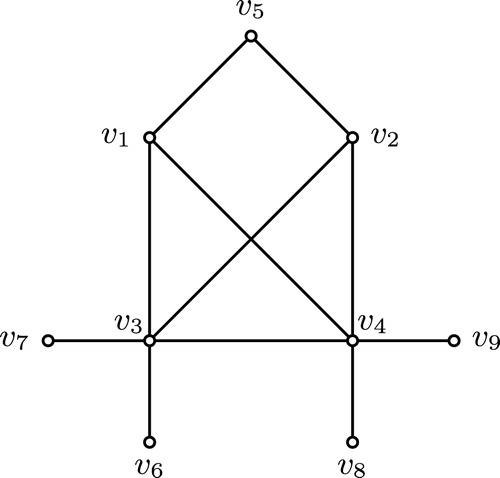 ?Mathematical formulae have been encoded as MathML and are displayed in this HTML version using MathJax in order to improve their display. Uncheck the box to turn MathJax off. This feature requires Javascript. Click on a formula to zoom.
?Mathematical formulae have been encoded as MathML and are displayed in this HTML version using MathJax in order to improve their display. Uncheck the box to turn MathJax off. This feature requires Javascript. Click on a formula to zoom.Abstract
Let be a commutative ring with identity. The comaximal ideal graph
of
is a simple graph with its vertices are the proper ideals of R which are not contained in the Jacobson radical of
, and two vertices
and
are adjacent if and only if
. In this paper, a dominating set of
is constructed using elements of the center when
is a commutative Artinian ring. Also we prove that the domination number of
is equal to the number of factors in the Artinian decomposition of
. Also, we characterize all commutative Artinian rings(non local rings) with identity for which
is planar.
1 Introduction
In recent years, the interplay between ring structure and graph structure is studied by many researchers. For such kind of study, researchers define a graph whose vertices are a set of elements in a ring or a set of ideals in a ring and edges are defined with respect to a condition on the elements of the vertex set. A graph is defined out of nonzero zero divisors of a ring and is called zero-divisor graph of a ring Citation[1]. Interesting variations are also defined like comaximal graph Citation[2], total graph Citation[3] and unit graph Citation[4] associated with rings. In ring theory, the structure of a ring is closely tied to ideal’s behavior more than elements, and so it is deserving to define a graph with vertex set as ideals instead of elements. In view of this, M. Behboodi and Z. Rakeei Citation[5,6] have introduced and investigated a graph called the annihilating-ideal graph of a commutative ring. The annihilating-ideal graph
of
is defined as the graph with the vertex set
and two distinct vertices
and
are adjacent if and only if
. In 2012, M. Ye and T. Wu defined a new graph structure on commutative rings in Citation[7]. They used ideals instead of elements of a ring, and they named such a graph structure, the comaximal ideal graph. The comaximal ideal graph
of
is a simple graph with its vertices the proper ideals of R which are not contained in the Jacobson radical of
, and two vertices
and
are adjacent if and only if
.
In 2016, Azadi et al. Citation[8] studied the graph structure defined by M. Ye and T. Wu. They investigated the planarity and perfection of comaximal ideal graph. Later, Visweswaran et al. Citation[9] studied the same and independently characterized commutative ring whose comaxial ideal graph is planar. The graphs constructed from rings help us to study the algebraic properties of rings using graph theoretical tools and vice-versa.
Let be a simple graph. The distance between two vertices
and
, denoted
, is the length of the shortest path from
to
. The diameter of a connected graph
is the maximum distance between two distinct vertices of
. The eccentricity of
, denoted
, is the maximum of the distances from
to the other vertices of
. The set of vertices with minimum eccentricity is called the center of the graph
, and this minimum eccentricity value is the radius of
. The status of
is sum of the distance from
to other vertices of
and is denoted by
. The set of vertices with minimal status is called the median of the graph
. For basic definitions on graphs, one may refer [Citation10].
In this paper, we find certain central sets in the comaximal ideal graph and use the same to obtain the value of certain domination parameters of the comaximal ideal graph. Also, we discuss about the planarity condition of the comaximal ideal graph of a commutative ring. The following results are useful for further reference in this paper.
Theorem 1.1
[11, Theorem 8.7] An Artinian ring is uniquely (up to isomorphism) a finite direct product of Artinian local rings.
Theorem 1.2
Citation[7, M. Ye and T. Wu] Let be a commutative ring. Then
is the empty graph if and only if
is a local ring.
Theorem 1.3
Citation[7, M. Ye and T. Wu] Let be a commutative ring. Then the following statements are equivalent:
is a complete graph
, where
and
are fields.
Theorem 1.4
Citation[7, M. Ye and T. Wu] For a ring , the following statements are equivalent:
is a complete bipartite graph
is a bipartite graph
has only two maximal ideals.
In view of Theorem 1.2, all rings are assumed to be non-local with identity, i.e., there are at least two maximal ideals in the ring.
2 Central sets in 

In 2016, Azadi et al. Citation[8] studied the comaximal ideal graph and determined conditions for the distance between two vertices is 1 or 2 or 3. By using these results one can conclude the central sets. But unfortunately, after finalising our manuscript for publication we came across this journal. Though we share the same results provided by us is independent.
In this section, we determine independently certain central sets in the comaximal ideal graph and use the same to obtain the value of certain domination parameters of the comaximal ideal graph. By Theorem 1.4, if , then the radius of
is either one or two. Hence in this section, we assume that
is a finite commutative ring with
.
Remark 2.1
By Theorem 1.3, the radius of is one if and only if
, where
and
are fields.
Let be a finite commutative ring with
, where each
is a local ring but not a field and
is a filed. Then
, where
and
for
and
.
Remark 2.2
Let be a finite commutative ring with
, where each
is a local ring but not a field and
is a filed. Then
for some
.
Theorem 2.3
Let be a finite commutative ring with
, where each
is a local ring but not a field and
is a filed. Then the radius of
is
and the center of
is
.
Proof
Let be any ideal of
with
, where
is an ideal in
and
is an ideal in
.
Case 1. . Then
.
By the assumption that ,
. For any ideal
in
,
is adjacent to some maximal ideal in
and
for
.
Suppose is maximal. Then
for some
. Note that each
is only not adjacent to
for every ideal
. Then by definition,
for all
and so
is a path of length
in
. Hence
and so
for all
.
Suppose is not maximal. Then
for some
and so
. If
for
, then there exist an ideal
(
) for some
such that
,
and
. Since
for some
,
is a path of length
and hence
. From this, we have
for all ideal
and
.
Case 2. . Then
and
.
Suppose is maximal. Then
for some
and
is not adjacent to
for all
with
,
and
. Since
for some
,
is a path of length
,
and hence
for all
.
If is not maximal, then
and
for some
and so
,
. Since
, there exist an ideal
with
such that
,
and
. Since
for
,
is a path of length
and so
. From this, we have
for all ideal
and
.
Case 3. and
. Then
.
Let be any nonzero ideal of
with
. Suppose
is maximal. Note that any ideal is adjacent to some maximal ideal. If
is an ideal not adjacent to
, then
for some maximal ideal
in
and
and so
is a path of length
. Hence
for all
.
Suppose is not maximal. Then
for some
. As in the proof of case 1 and case 2, we can find an ideals
and
such that
is not maximal and
is a path of length
and hence
. From this, we have
for all ideal
and
.
Hence in all cases, the center of is
. □
Theorem 2.4
Let be a finite commutative ring with
, where each
is a local ring but not a field and
is a filed. Then the median is a subset of the center of
.
Proof
By Theorem 2.3, the radius of is
and the center of
is
. Let
be the number of proper ideals in
. Let
be any ideal in
with
. Suppose
is maximal. Then
(1)
(1) Note that Eq. (1) implies that all the vertices of the median must have the same degree. If
is any ideal in
but
is not maximal, then there exists an ideal
such that
and so
(2)
(2) Thus there is a maximal ideal
with
for
and so any ideal not in the center of
cannot be in the median of
. Hence the median is a subset of the center of
. □
Corollary 2.5
Let be a finite commutative ring with
, where each
is a local ring but not a field and
is a filed. Then the median of
is
.
Proof
Let be the number of ideals in
for
. Then
. Clearly by the definition of
,
,
and so
. By Eq. (1),
. Since
for all
,
for all
and hence the median of
is
. □
Corollary 2.6
Let be a finite commutative ring with
, where each
is a filed. Then the median and center of
are equal.
Proof
This follows from Corollary 2.5. □
Theorem 2.7
Let be a finite commutative ring with
, where each
is a local ring but not a field. Let
be the number of ideals in
for
. Then the median and center of
are equal if and only if
for all
.
Proof
Suppose for all
. Then by definition of
,
for all
. By Theorems 2.3 and 2.4, the median of
is
.
Conversely, assume that the median and center of are equal. As in proof of Theorem 2.3, the median of
is
. Suppose
for some
. Without loss of generality, we assume that
. Then
and so
, a contradiction. □
The following result proved by Meng Ye et al. Citation[7, Theorem 4.8] is used frequently and hence given below.
Theorem 2.8
Citation[7, Theorem 4.8] For a ring
,
is the finite complete bipartite graph
(where
and
are finite integers) if and only if
, where
and
are artinian local rings with
and
ideals respectively.
For a ring
,
is a finite star graph
if and only if
, where
is a field and
is an artinian local ring with exactly
ideals.
In view of Theorem 2.8(2), we have the following, if and only if
, where
is a field and
is an artinian local ring.
Also if and only if
, where each
is an artinian local ring but not a field.
Theorem 2.9
Let be a finite commutative ring with
, where each
is a local ring but not a field and
is a filed. Then
.
Proof
Let . Let
be any ideal in
. Then by definition,
is adjacent to some maximal ideal in
. Hence
is a dominating set of
and so
.
Suppose is a dominating set for
. Since
has no vertex adjacent to all others,
. For each
, let
, where
or
and
or
for all
. For each
, let
, where
or
and
or
for all
. Then, each
and
is a vertex of
. For each
, the element
is only adjacent with the element
. That is, for each
, either
or
. Thus
contains at least
elements and so
. □
In view of Theorem 2.9, we have the following, is a
-set of
.
Theorem 2.10
Let be a finite commutative ring with
, where each
is a local ring but not a field and
is a filed. Then
.
Proof
For each ,
is an independent set of
. Let
with
. Then
is an independent dominating set of
and so
. □
3 Isomorphism properties of 
 and planarity of
and planarity of 

Consider the question: If and
are two rings with
, then do we have
The following example shows that the above question is not valid in general.
Example 3.1
Let and
. Then
(see. ). But
and
are not isomorphic.
Theorem 3.2
Let and
be finite commutative rings with
, where each
and
are local rings but not field and each
and
are field. Let
be the number of ideals in
and
be the number of ideals in
. Then
if and only if
for all
,
.
Proof
If , then the result is obvious. Assume that
. Suppose
for all
,
. Then
. Let
be the set of ideals in
and
be the set of ideals in
. Then the map
is a bijection from
onto
. Define
by
where
Then
is well-defined and bijective. Let
and
be two non-zero ideals in
. Suppose
and
are adjacent in
. Then
and so
and
for all
. Let
and
. By definition of
,
and
for all
and so
. Hence
and
are adjacent in
. Similarly one can prove that
preserves non-adjacency also. Hence
.
Conversely, assume that . Suppose
for some
. Then
, a contradiction. Hence
for all
. □
Example 3.3
Let and
. Then
(by Theorem 2.8). But
and
are not isomorphic.
Using Theorem 3.2, one can have the following corollary.
Corollary 3.4
Let and
, where each
and
are fields and
. Then
.
Corollary 3.5
Let and
be finite commutative rings with
, where each
and
are local rings but not field. Let
be the number of ideals in
and
be the number of ideals in
. Then
if and only if
for all
,
.
In view of the above it is natural to consider the question that whether the comaximal-ideal graph is isomorphic to the zero-divisor graph or the annihilating ideal graph. In Citation[7], it has been proved that for a finite commutative ring , where
is field and
, the co-maximal graph
of
is isomorphic to the zero-divisor graph of
. In this section, we prove that the comaximal ideal graph of a particular ring is isomorphic to the annihilating-ideal graph of an another ring.
Theorem 3.6
Let and
where each
is a field and
. Let
be the zero-divisor graph of
. Then
.
Proof
Note that ,
and
.
Define by
where
Clearly
is well-defined and bijective. Let
and
be two non-zero ideals in
. Suppose
and
are adjacent in
. Then
and so
for all
. Hence
or
for all
. Suppose
and
. Then either
or
and so
for all
. i.e,
and so
and
are adjacent in
. Similarly one can prove that
preserves non-adjacency also. Hence
. □
In Citation[8], Azadi et al. have proved that the comaximal ideal graph is planar, when . But here we proved that the comaximal ideal graph is non-planar, when
by the simple observation of the following remark. In Citation[9], Visweswaran et al. have characterized the commutative ring whose comaxial ideal graph is planar. Here we give a simple proof of the same.
Remark 3.7
Note that if , then
is nonplanar. Hence if
where
is field and
. Then
is planar if and only if
or
.
Theorem 3.8
Let be a finite commutative ring with
, where each
is a local ring but not field and each
is a field. Then
is planar if and only if
satisfies any one of the following conditions:
or
and
is the only nonzero proper ideal in
or
where
has at most
nonzero ideals and
has at most
nonzero ideals and
has at most
nonzero ideals and
has at most
nonzero ideals.
Proof
Suppose is planar. Note that
is a subgraph of
. Suppose
. Since
is nonplanar,
is nonplanar and hence
.
Case 1.Suppose .
subcase 1. and
. Then by Remark 3.7,
.
subcase 2. and
. Let
where
,
,
,
,
,
,
,
,
. Then
is a subgraph of
,
contains a subdivision of
(see ) and hence
is nonplanar.
subcase 3. If and
, then
.
Let where
,
,
,
,
,
,
. Then
is a subgraph of
,
contains a subdivision of
(see ) and hence
is nonplanar.
subcase 4. If and
, then
. Suppose
is any nonzero proper ideal in
and
. Let
where
,
,
,
,
,
. Then
is a subgraph of
,
contains a
as a subgraph and so
is nonplanar. Hence
is only nonzero proper ideal in
. Let
where
,
,
,
,
. Since
is planar and by ,
and
is only nonzero proper ideal in
.
Case 2. . Then by Theorem 2.8,
is a complete bipartite graph. Since
is planar,
or
.
If , then by Theorem 2.8,
where
and
are number of nonzero ideals in
and
respectively. Since
is planar, either
and
or
or
.
Converse is obvious. □
Acknowledgments
The authors wish to record their sincere thanks to the anonymous referees for carefully reading the manuscript and making suggestions that improve the content and presentation of the paper.
References
- AndersonD.F.LivingstonP.S., The zero-divisor graph of a commutative ring J. Algebra 2171999 434–447
- MaimaniH.R.WickhamC.YassemiS., Comaximal graph of commutative rings J. Algebra 3192008 1801–1808
- AndersonD.F.BadawiA., The total graph of a commutative ring J. Algebra 3202008 2706–2719
- AshrafiaN.MaimanibcH.R.PournakicdM.R.YassemieS., Unit graphs associated with rings Comm. Algebra 382010 2851–2871
- BehboodiM.RakeeiZ., The annihilating-ideal graph of commutative rings I J. Algebra Appl. 10 4 2011 727–739
- BehboodiM.RakeeiZ., The annihilating-ideal graph of commutative rings II J. Algebra Appl. 10 4 2011 741–753
- YeM.WuT.S., Comaximal ideal graph of commutative rings J. Algebra Appl. 112012 1250114 14 pages
- AzadiM.JafariZ.EslahchiC., On the comaximal ideal graph of a commutative ring Turkish J. Math. 402016 905–913
- VisweswaranS.ParejiyaJ., Some results on the comaximal ideal graph of a commutative ring J. Algebra Combin. Discrete Struct. Appl. 5 2 2018 85–99
- ChartrandG.LesniakL., Graphs and Digraphs1986Wadsworth and Brooks/ ColeMonterey, CA
- AtiyahM.F.MacdonaldI.G., Introduction To Commutative Algebra1969Addison-Wesley Publishing Company




